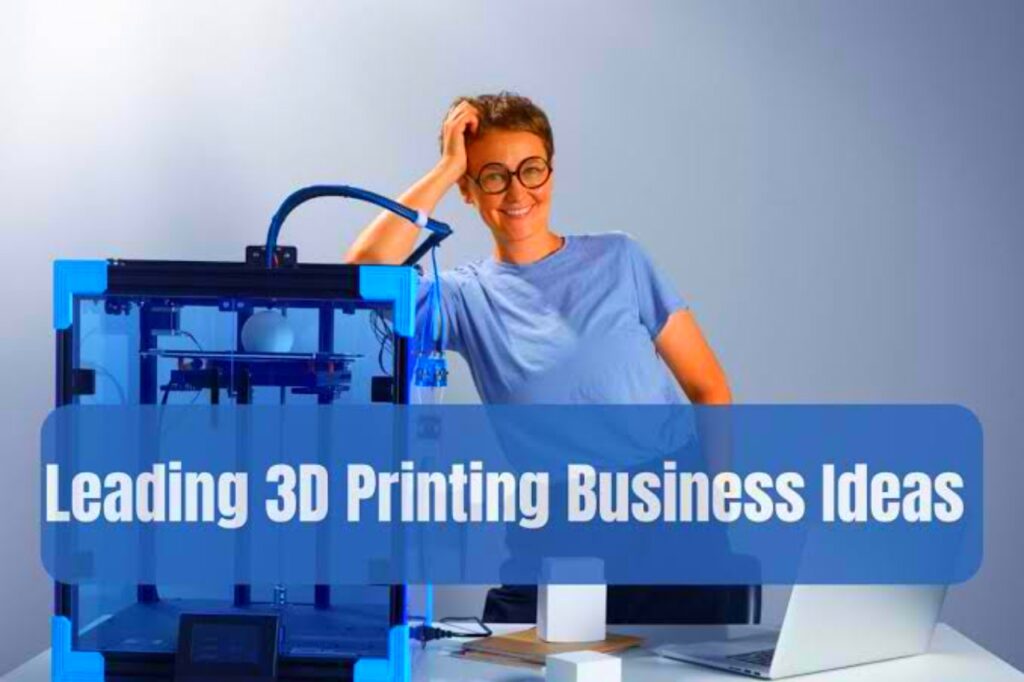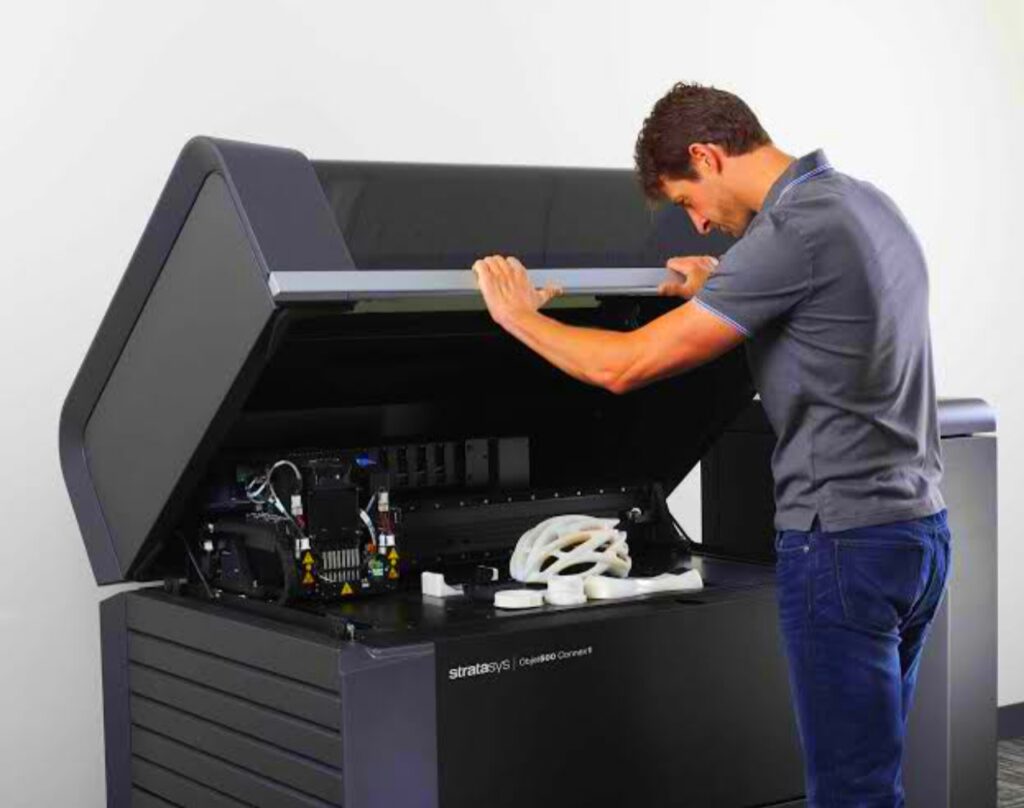3D Printing Business has become popular in recent years as a novel method with the capacity to revolutionise a variety of sectors. This cutting-edge method, also known as additive design, enables the manufacture of three-dimensional things by layering materials based on computer blueprints. As 3D printer capabilities and accessibility grow, new business prospects in this industry have emerged. In this post, we will look at a few 3D printing company ideas that have the potential to succeed in today’s market.

Investigating Business Opportunities in 3D Printing
1. Customised Product Development
One of the most intriguing aspects of 3-D printing is its ability to create significantly customised products. Businesses that use this technology can offer personal things to clients including jewelery and accessories to home decor and consumer goods. The distinctive selling point is that tailor-made solutions that suit to individual tastes and demands are provided.

2. Services for Rapid Prototyping
Rapid prototyping enabled by 3D printing has substantially altered the product development process. Businesses may take advantage of this potential by providing prototype services to manufacturers, engineers, and designers. Companies can swiftly build tangible prototypes using 3D printers, allowing clients to test and modify their concepts before investing in mass production.
3. Sales of 3D Printing Supplies and Equipment

With the expanding need for 3D printing supplies and equipment, this industry is in high demand. Starting a business that sells 3D printers, filaments, replacement parts, and accessories might be a profitable endeavour. Such a firm, which caters to the demands of both experts and amateurs, may capitalise on the continued development in the usage of 3D printing technology.
Services for Design and Modelling
Offering design and modelling services may be extremely beneficial to firms and people that lack the essential design abilities or access to 3D modelling software. A 3D printing company may help clients turn their ideas into printable files by employing expert designers and utilising innovative tools. This service is applicable to a wide range of sectors, including architecture, product design, and engineering.
Programmes for Education and Training
As 3D printing evolves, there is a growing demand for education and training programmes to provide individuals with the skills needed to properly exploit this technology. Starting a 3D printing training centre or providing online courses might be lucrative business ventures. These programmes may serve to both novices who want to learn the fundamentals of 3D printing and professionals who want to expand their knowledge in specialised areas.
Applications in Medicine and Dentistry
The use of 3D printing machines has resulted in substantial advances in the medical and dentistry business sectors. Customised implants, prostheses, and dental models may now be manufactured with pinpoint accuracy. A company that specialises in 3D-printed medical and dental solutions can meet the rising need for personalised healthcare items.
Models of architecture and construction
Architects and real estate developers frequently demand precise and detailed models to demonstrate clients their concepts. Businesses may provide a physical picture of projects by supplying architectural and construction models generated using 3D printing. This enables clients to visualise the end result and make educated decisions, easing the sales process.
8. Fashion Accessories and Jewellery
3D printing opens us a world of possibilities for making one-of-a-kind and exquisite jewellery and fashion items. Businesses may give clients original and customised things by combining smart design with the flexibility of 3D printing. Individuals may express their particular style through wearable art in this way.
How to Launch a 3D Printing Company

Starting a 3D printing company involves meticulous preparation and effective execution. Here are the essential first steps:
1. Carry out market research
It is critical to undertake extensive market research before entering the 3D printing sector. Analyse the need for 3D printing services in your target market, identify prospective rivals, and look for gaps or niche possibilities.
2. Identify Your Niche
With so many business opportunities in the 3D printing market, it is critical to find your expertise. Concentrate on a single topic that corresponds to your knowledge and market need. You may build a strong brand presence and separate yourself from competition by specialising in a certain segment.
3. Obtain the Required Equipment and Materials
Purchase high-quality 3D printers, software, and other equipment required for your chosen company strategy. Different sorts of printers, such as desktop ones or industrial-grade equipment, may be required depending on your specialisation. Also, have a consistent supply of high-quality printing materials on hand, such as filaments or resins.
4. Improve Your Design and Printing Ability
It is critical to polish your design and printing abilities in order to produce great products and services. Maintain current knowledge of software and design processes, and devote time to continual study. This will enable you to produce high-quality product while meeting consumer expectations.
5. Establish Your Online Presence
In the digital age, having a good online presence is critical. Make a professional website highlighting your skills, portfolio, and contact information. To reach a larger audience and attract new clients, use social media platforms and online marketplaces.
6. Form Strategic Partnerships
Collaborating with other organisations and experts in related sectors might help you extend your reach and client base. Develop relationships with manufacturers, designers, architects, and other key stakeholders to develop cooperation and cross-promotion opportunities.
7. Promote Your Company
To advertise your 3D printing firm, develop a complete marketing plan. Use a combination of online and offline marketing strategies, such as content marketing, search engine optimisation (SEO), social media advertising, attending industry events, and participating in trade exhibits. Customise your messaging to showcase the unique qualities of your company and to address the specific demands of your target audience.
8. Provide Outstanding Customer Service
Provide outstanding client service to develop a good reputation and encourage consumer loyalty. Respond to questions quickly, resolve customer problems, and guarantee that products and services are delivered on schedule. Exceeding consumer expectations will help you develop a favourable brand image and attract repeat business.
FAQs (Frequently Asked Questions)
1. Is 3D printing a lucrative enterprise?
ANS– Yes, 3D printing may be a lucrative business provided you locate the correct niche, produce high-quality products or services, and advertise your company efficiently. With the rising need for customised and quick prototyping solutions, the 3D printing sector offers several opportunities for income generation.
2. How much does it cost to launch a 3D printing company?
ANS– The cost of beginning a 3D printing business depends on a variety of criteria, including the type of printers and equipment you pick, the size of your operation, and the scope of your services. A basic desktop 3D printing system can cost a few thousand dollars, but an industrial-grade configuration might cost tens of thousands to hundreds of thousands of dollars.
3. What qualifications do I need to establish a 3D printing company?
ANS– It is advantageous to have expertise in 3D modelling and design tools, as well as understanding of the printing process and materials, before starting a 3D printing firm. Furthermore, business and marketing knowledge will be useful for properly advertising and managing your enterprise.
4. Is it possible to establish a 3D printing business from home?
ANS– Yes, you can start a 3D printing business from home, particularly if you focus on smaller-scale projects or provide online services. However, keep in mind the space requirements, noise levels, and any municipal ordinances or zoning limitations that may apply to operating a company from your home.
5. What are the legal implications of 3D printing?
ANS–Yes, there are legal implications to 3D printing that you should be aware of. Intellectual property rights, copyright infringement, and licencing agreements are examples of these. Make sure you respect others’ intellectual property and understand the legal ramifications of copying copyrighted designs.
Finally,
For budding entrepreneurs, the sector of 3D printing provides a wealth of business prospects. You can explore various niches such as customised product creation, rapid prototyping services, supplies and equipment sales, design and modelling services, education and training programmes, medical and dental applications, architectural and construction models, and jewellery and fashion accessories by leveraging the versatility and customization capabilities of 3D printing technology.
Conduct thorough market research, determine your niche, acquire the right equipment and materials, develop your design and printing skills, establish your online presence, forge strategic partnerships, implement effective marketing strategies, and prioritise excellent customer service to start a successful 3D printing business. You can position your 3D printing firm for success in this fast developing sector with careful planning, effort, and a focus on producing excellent goods and services.
READ MORE – Comcast Business Modem : Comcast Business Login And Account


